

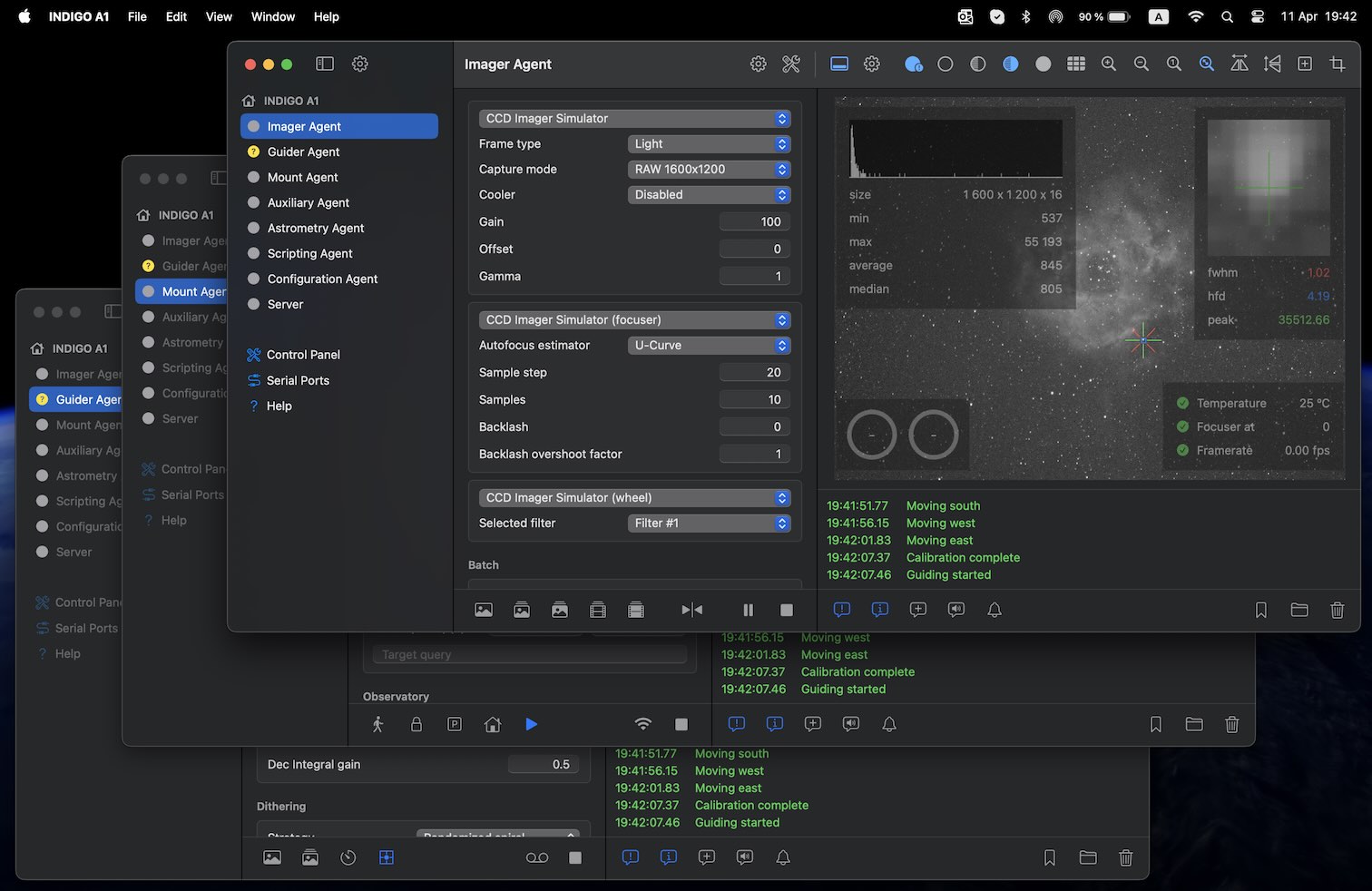

We're passionate about advancing the capabilities of macOS, iOS, and Linux to serve as leading platforms for astronomy and astrophotography professionals and enthusiasts. Our aim is to provide a comprehensive suite of tools and resources on these operating systems, ensuring they rival the offerings available on other platforms. As proud co-founders of the INDIGO Initiative, we are deeply involved in shaping a standardized ecosystem and framework for multiplatform and distributed astronomy software. This initiative not only streamlines development but also enhances compatibility and interoperability across diverse systems.
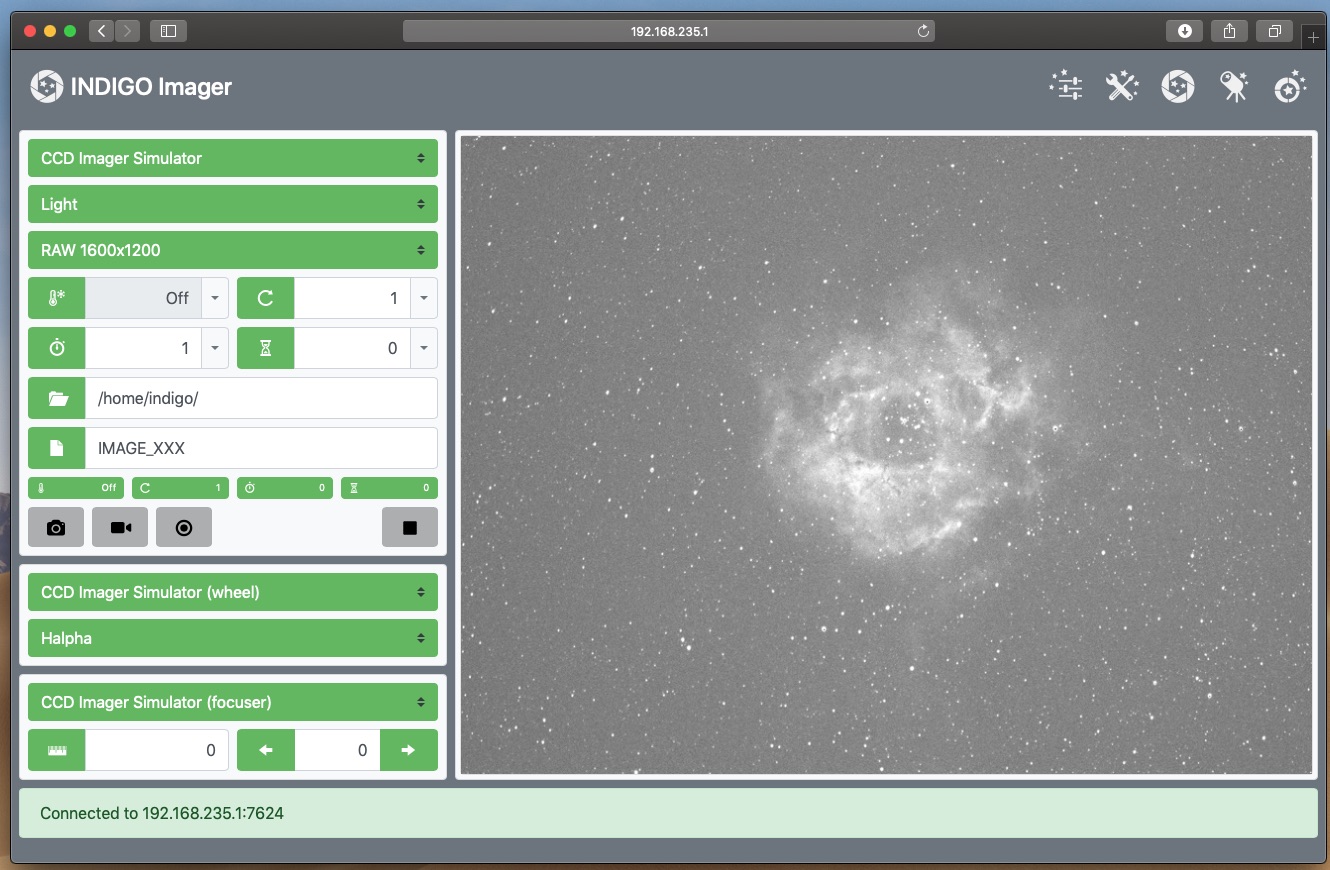
At the heart of our commitment lies the INDIGO framework and driver stack, representing a modern alternative to the outdated INDI framework. By embracing this cutting-edge technology, we empower users to seamlessly integrate our astronomy applications into their workflows, whether they are on a single device or distributed across multiple platforms. For instance, imagine leveraging a macOS application as a client, communicating effortlessly with an INDIGO server running on a Raspberry Pi. Such flexibility and versatility are at the core of our mission to democratize access to advanced astronomical tools.
For those eager to explore the possibilities offered by our applications in a distributed environment, we encourage a visit to the INDIGO Initiative pages. Here, users can ascertain the compatibility of their hardware and effortlessly download the necessary binary packages. Our commitment to user experience extends beyond the functionality of our software; it encompasses accessibility and ease of implementation, ensuring that enthusiasts at all levels can engage with astronomy and astrophotography with confidence.
As advocates for innovation and collaboration within the astronomical community, we are continuously refining and expanding our offerings. Through ongoing research and development, we strive to push the boundaries of what is achievable with Linux, macOS, and iOS, fostering a vibrant ecosystem of tools and resources that cater to the diverse needs of astronomers worldwide. Join us on this exciting journey as we pave the way for a future where astronomy is more accessible, interconnected, and awe-inspiring than ever before.

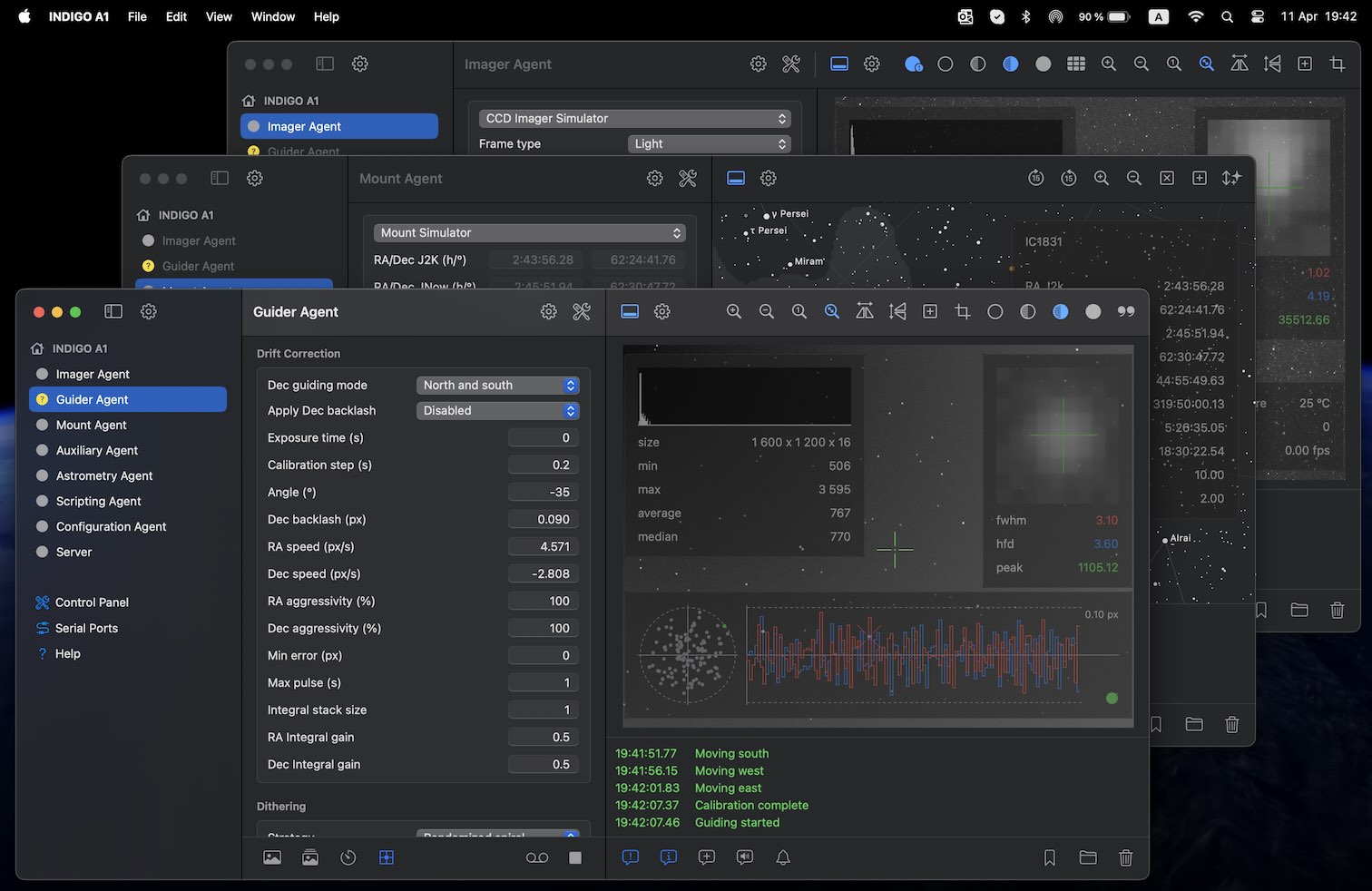


INDIGO A1 is a versatile graphical user interface designed for use with both external and built-in INDIGO servers. Developed to be truly multiplatform, it is compatible with macOS, iPadOS (operating without the built-in server feature), and iOS (excluding the built-in server functionality and subject to additional limitations which will be elaborated upon subsequently). This wide-ranging compatibility ensures that users can manage and interact with the INDIGO server across various devices, enhancing accessibility and user experience in astronomical software management.

The software offers comprehensive control over image capture, guiding, and mount operation, facilitating seamless astronomical photography sessions. With its intuitive interface, users can effortlessly adjust exposure settings, capture multiple frames, and execute precise image stacking for optimal results. It integrates advanced guiding functionalities, enabling users to maintain accurate tracking of celestial objects over extended periods, crucial for capturing long-exposure images. Control over telescope mounts and auxiliary devices such as focusers and filter wheels is streamlined, allowing for precise adjustments and automated sequences tailored to specific imaging goals.
Plate solving capabilities within the software swiftly analyze captured images, accurately identifying celestial objects and providing precise coordinates for precise targeting and framing. Advanced scripting and automation features empower users to create custom workflows and sequences, automating repetitive tasks and maximizing efficiency during imaging sessions.
Real-time monitoring and feedback mechanisms provide users with crucial information on equipment status, guiding accuracy, and imaging progress, enabling timely adjustments for optimal results. Whether deployed on a single computer or in distributed setups across multiple devices, the software synchronizes seamlessly, ensuring consistent performance and data integrity.
Its compatibility with various astrophotography equipment brands and models enhances versatility, catering to the diverse needs of amateur and professional astronomers alike. Regular updates and community-driven support channels ensure ongoing development and enhancement, keeping the software at the forefront of astrophotography technology and meeting the evolving needs of enthusiasts and professionals.
INDIGO A1 replaces retired INDIGO D1, AstroImager, AstroDSLR, AstroGuider, AstroTelescope and INDIGO Server products. It requires macOS 13.0 or later and iOS/iPadOS 16.0 or later.

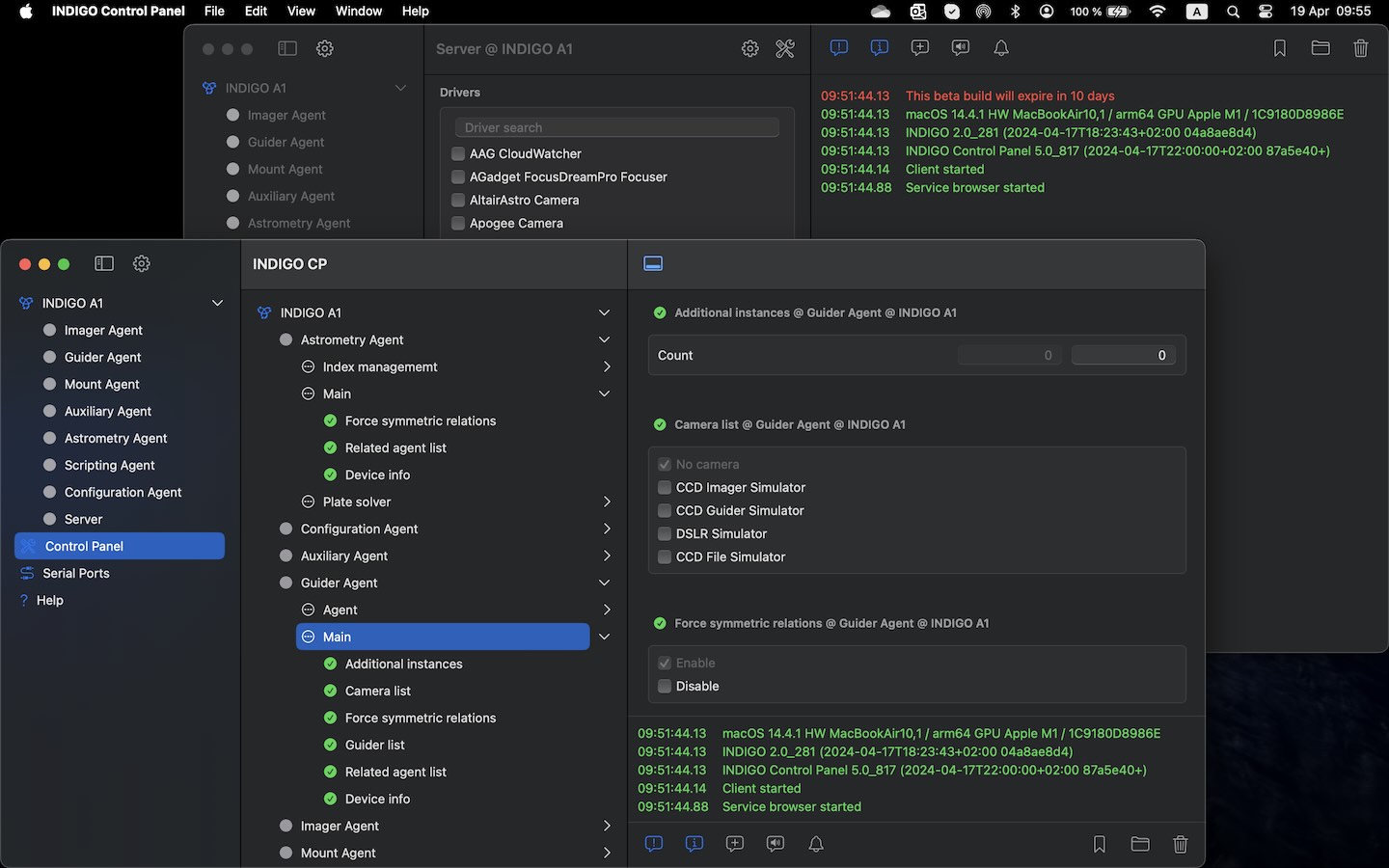


The INDIGO Control Panel is a simplified variant of the INDIGO A1, tailored specifically for streamlined access to essential functionalities. It provides an interface for managing INDIGO or INDI servers, along with configuration controls for the server itself and for serial ports used by various drivers and the full version of the control panel. This specialized version focuses on delivering a direct view of agents' properties, offering users a clear and concise operational experience.
Unlike the INDIGO A1, the INDIGO Control Panel does not include agent-specific panels nor does it incorporate a built-in INDIGO server. This simplification allows for a more lightweight and focused tool, suitable for users who require direct and straightforward management capabilities without the complexities of additional features.
Designed for versatility, the INDIGO Control Panel is compatible with macOS, iPadOS, and iOS platforms, ensuring a broad range of device usability. This cross-platform functionality makes it an ideal choice for users who need to manage their systems on the go, providing reliable control across different operating environments.
INDIGO Control Panel requires macOS 13.0 or later and iOS/iPadOS 16.0 or later.

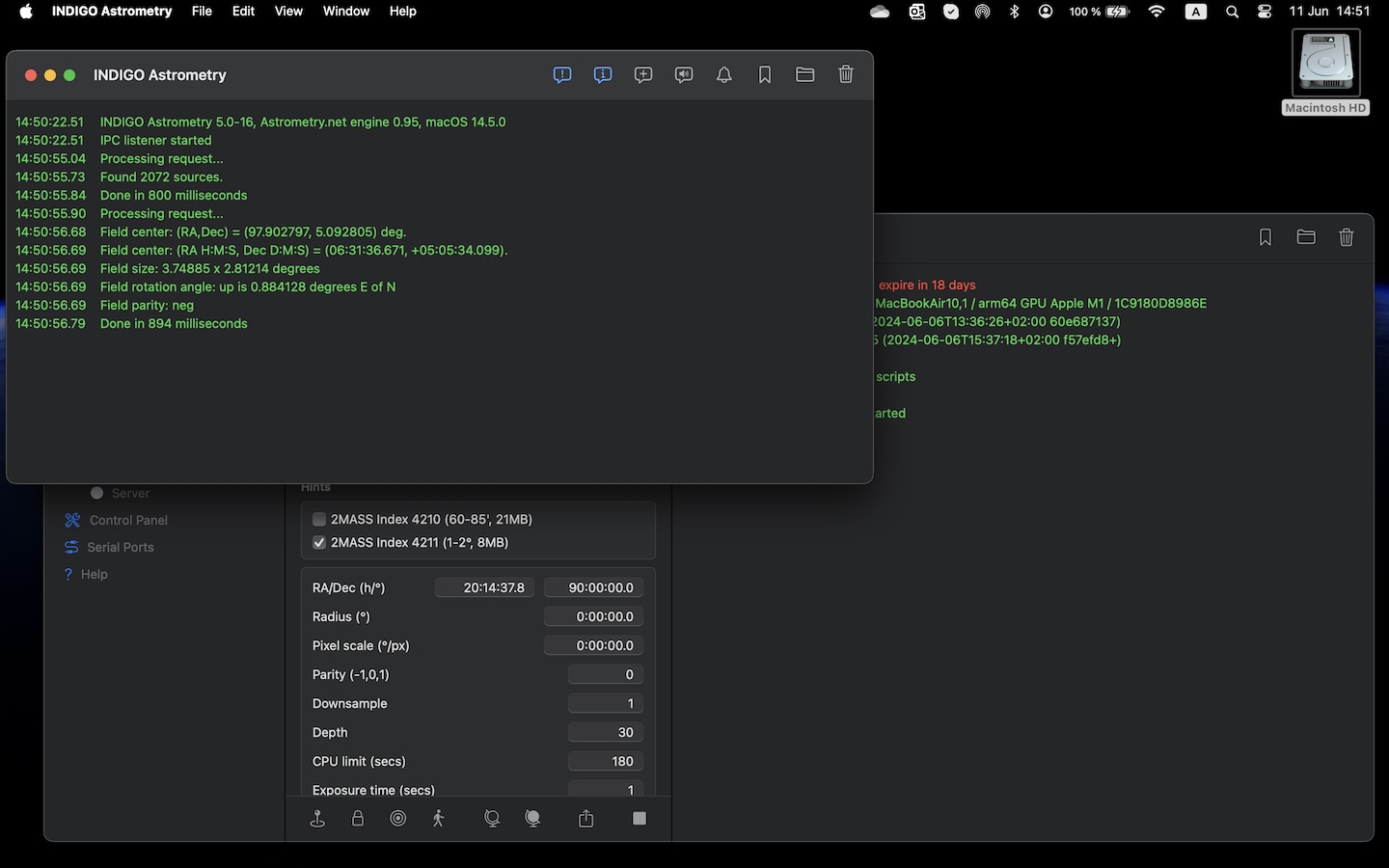
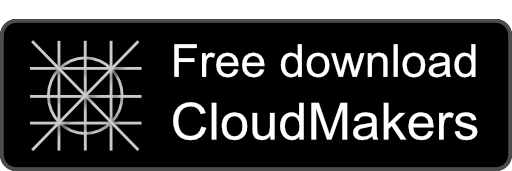
Astrometry is a stripped down native port of the astrometry.net system, featuring an IPC service server and a macOS GUI wrapper. It integrates seamlessly with Astrometry agent distributed within INDIGO A1 and other INDIGO based macOS backends, enhancing their image-solving capabilities.
This version of the astrometry.net package is a streamlined adaptation, deliberately simplified for ease of use. Unlike the full astrometry.net package, it foregoes Python scripts and third-party image conversion programs. Consequently, it exclusively supports FITS files and does not generate any graphical plots, focusing on core functionality without added complexity.
The simplified approach ensures that INDIGO Astrometry remains user-friendly and efficient, ideal for users who require a straightforward astronomical image-solving tool without the need for extensive data manipulation or visualization features. This makes it particularly suitable for astronomers who prioritize speed and simplicity in their workflow.
INDIGO Astrometry is free and open source software.

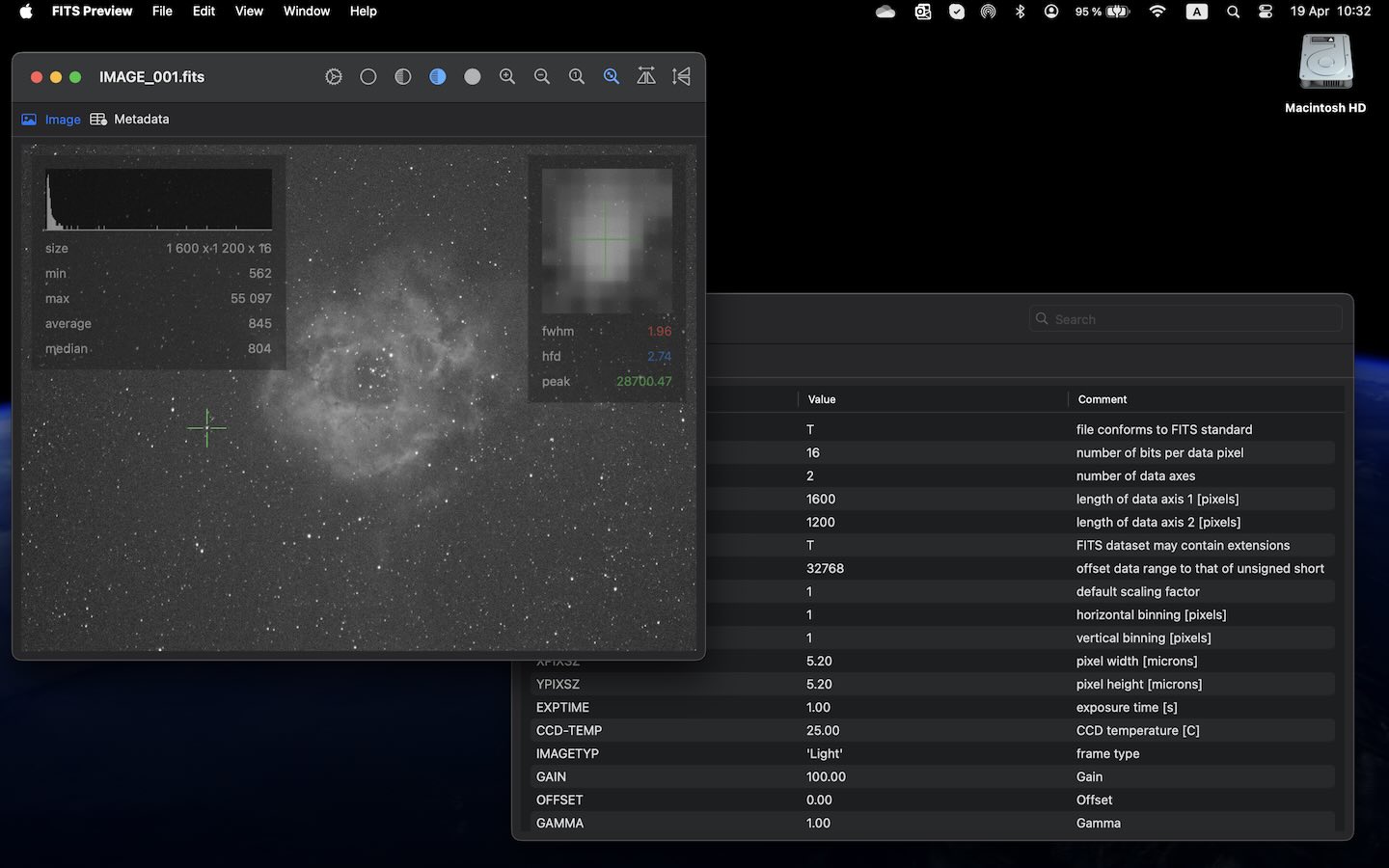


FITS Preview is a streamlined viewer specifically designed for images in the FITS format (Flexible Image Transport System). This format was introduced by NASA and the High Energy Astrophysics Science Archive Research Center (HEASARC) to facilitate the robust transmission and manipulation of astronomical data.
Unlike comprehensive FITS editors, FITS Preview stands out for its speed and user-friendliness. The application is tailored for users who need quick, efficient access to view their astronomical images without the overhead of complex editing features.
The viewer's ease of use is highlighted by its straightforward functionality: a double-click on any FITS file across various directories prompts FITS Preview to open it instantly. The application automatically adjusts the image to fit the viewing window and optimizes brightness, while also allowing for adjustments in image orientation and rotation as needed.
Additional features of FITS Preview include the ability to view the file header and the image histogram, which are essential for analyzing the data contained within the images. Users can also view raw images in color by selecting the correct Bayer matrix offset, thus enhancing the visual data interpretation.
FITS Preview is based on the CFITSIO library, supporting both standard monochrome and color FITS image formats. This compatibility ensures that FITS Preview can be used seamlessly within various astronomical data analysis workflows, providing a reliable and efficient tool for image viewing and preliminary data assessment.


INDIGO Server is backend counterpart for INDIGO clients in distributed environments. It is bundled with all available drivers (crossplatform and macOS specific).
INDIGO Server is a server part of INDIGO framework wrapped into macOS GUI. It is INDIGO based replacement for INDI Server.
Even if it can be used separately, it is meant to work together and with other INDIGO based astronomy and astrophotography tools provided by CloudMakers and other vendors.
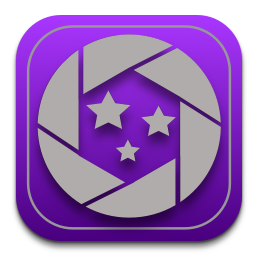
AstroImager is a front end for imaging and auxiliary devices INDIGO agents. Its purpose is to control main imaging camera, filter wheel and focuser, to allow proper framing, focusing and capturing from a single batch of images to quite complicated series of images with different parameters and settings.
It also controls the set point cooling and the mechanical shutter of the attached camera (if available). It can preview or capture and save images to selected folder with any file name prefix, count, duration and time lapse, browse captured images and show them in Finder, zoom and stretch them automatically or manually. It can measure FWHM, HFD and the drift of a selected star to help easier and faster focus and align your equatorial telescope mount. Captured images can be plate-solved using public or local astrometry.net service.
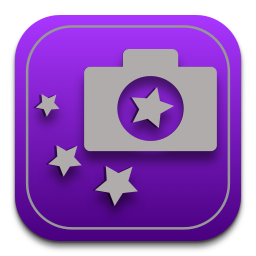
AstroDSLR is a front end for imaging and auxiliary devices INDIGO agents with GUI controls specific for DSLRs (Nikon, Canon, Sony and Fuji). Its purpose is to control main imaging camera and focuser, to allow proper framing, focusing and capturing from a single batch of images to quite complicated series of images with different parameters and settings.
It controls ISO, aperture (if lens mounted), shutter speed and BULB exposure length, exposure compensation, metering and focusing modes, white balance, image quality and format. It can preview (optionally using LiveView) or capture and save images to selected folder with any file name prefix, count and time lapse, browse captured images and show them in Finder, zoom and stretch them automatically or manually. It can measure FWHM, HFD and the drift of a selected star to help easier and faster focus and align your equatorial telescope mount. Captured images can be plate-solved using public or local astrometry.net service.
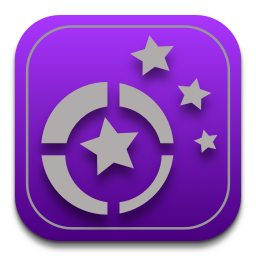
AstroGuider is a front end to a guider INDIGO agent. Its purpose is to control the guiding camera, its guider port and/or the connected mount. It can be calibrated automatically or manually, you do not need to take care about camera orientation or pixel scale.
It can use various drift detection and drift response algorithms and can autodetect one or multiple stars to guide with. It can also cooperate with AstroImager or AstroDSLR (e.g. for dithering) or with AstroTelescope (e.g. to stop guiding when the mount is slewed to another target).

AstroTelescope is a front end to mount and auxiliary devices INDIGO agents, it is a simple planetarium and telescope control application for astrophotography.
Star map in AstroTelescope can be displayed in any scale and rotated by any angle, with selectable star density and with or without star names. Hipparcos Catalogue and selected NGC and IC DSO objects are available from the application locally, but any object can be searched online by calling public SIMBAD service on Strasbourg Astronomical Data Center.
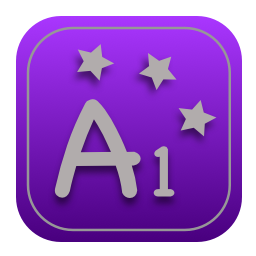
INDIGO A1 is a front end for imaging, guiding, mount and auxiliary devices INDIGO agents. Its purpose is to control main imaging camera, filter wheel and focuser, to allow proper framing, focusing and capturing from a single batch of images to quite complicated series of images with different parameters and settings, to control the guiding camera, its guider port and/or the connected mount and it is a simple planetarium and telescope control application.
It is actually AstroImager, AstroGuider and AstroTelescope bundled together to a single process together with utilities like AUX Panel, INDIGO Control Panel and INDIGO Script Editor, so everything what you can read about these applications applies to INDIGO A1 as well.

INDIGO D1 is a front end for imaging, guiding, mount and auxiliary devices INDIGO agents. Its purpose is to control main imaging camera, filter wheel and focuser, to allow proper framing, focusing and capturing from a single batch of images to quite complicated series of images with different parameters and settings, to control the guiding camera, its guider port and/or the connected mount and it is a simple planetarium and telescope control application.
It is actually AstroDSLR, AstroGuider and AstroTelescope bundled together to a single process together with utilities like AUX Panel, INDIGO Control Panel and INDIGO Script Editor, so everything what you can read about these applications applies to INDIGO D1 as well.